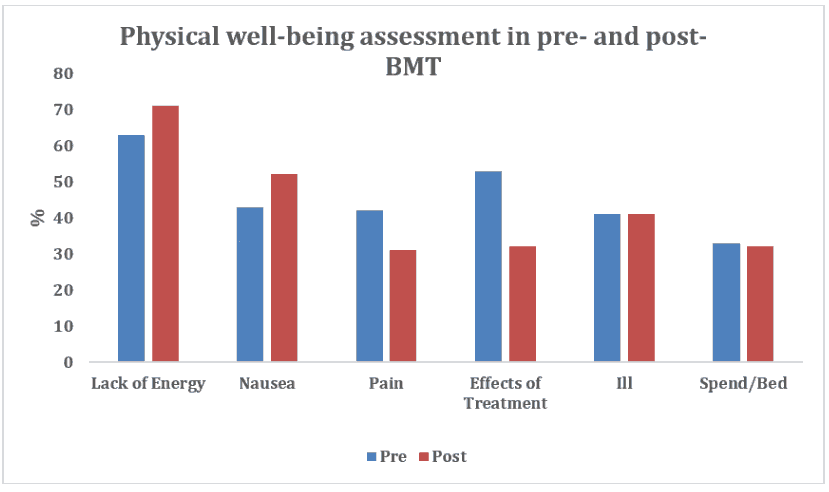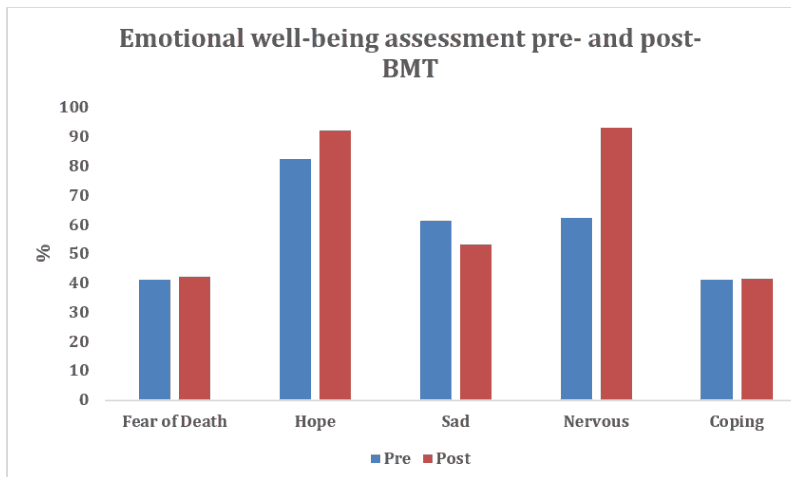Multiple Myeloma
Martino et al., 2017 assessed the QoL in patients with multiple myeloma who had undergone autologous stem cell transplantation (ASCT). Based on the patient’s preference for inpatient or outpatient care model, QoL was assessed using FACT-BMT at three points; 7 days before ASCT (Baseline), 7+ days after ASCT and 30+ days after ASCT. Using the FACT-BMT, QoL differences between inpatients and outpatients were compared. Inpatients showed a higher mean score compared to outpatients in physical well-being. However, outpatients showed a higher mean score for social/family well-being in comparison to inpatients.
Graft-versus-host disease
Pulewka et al., 2017 focused their attention on graft-versus-host disease after allogeneic hematopoietic stem-cell transplantation (alloHSCT). The study compared QoL assessment through FACT-BMT for adolescent and young adult (AYA) and elderly patients. Assessment comparison revealed that AYA group reported higher physical well-being and activity scores on the FACT-BMT assessment than the non-AYA group.
Sexual dysfunction and infertility post-BMT
In a study by Dyer et al., 2016, 421 adult survivors of allogeneic hematopoietic stem cell transplant (HSCT) were surveyed for sexual dysfunction and infertility. The survey showed that females who had returned to sexual activity had significantly higher FACT BMT subscale scores, but did not have any significant differences across other FACT domains.
Post-traumatic stress disorder
Hospitalization during hematopoietic stem cell transplantation (HCT) is known to have a deteriorating impact on the QoL of the patients. El-Jawahri’s et al.,2016 study aimed to correlate QoL with the probability of PTSD in patients hospitalized for HCT. Based on the FACT-BMT assessment, which was carried out pre-transplant (Baseline) and 6 months after the transplant, a decline in QoL was found to be significantly associated with PTSD symptoms in patients after 6 months since HCT. The assessment further highlighted the impact of marital status as a notable predictor of PTSD, as married patients showed fewer symptoms of PTSD after HCT.
QoL in the elderly post HCT
Elderly patients with hematologic malignancies are recommended the HCT as the only curative option. In their study, Hamilton et al., 2014 surveyed patients aged 60 and above using FACT-BMT and compared it with patients aged under 60. Their results showed that there was a significant increase in social well-being and results were comparable in their positivity to patients under the age of 60.
Thalassemia
La Nasa’s et al., 2013 study aimed to investigate the QoL in β-thalassemia major patients who had undergone HSCT. The FACT-BMT assessment was done 20 years after the transplant with the aim to view the difference in health-related QoL of these ex-patients with the general population. The assessment revealed that patients with the confirmed association of GVHD and those with comorbidities or living alone had lower scores of FACT-BMT.



